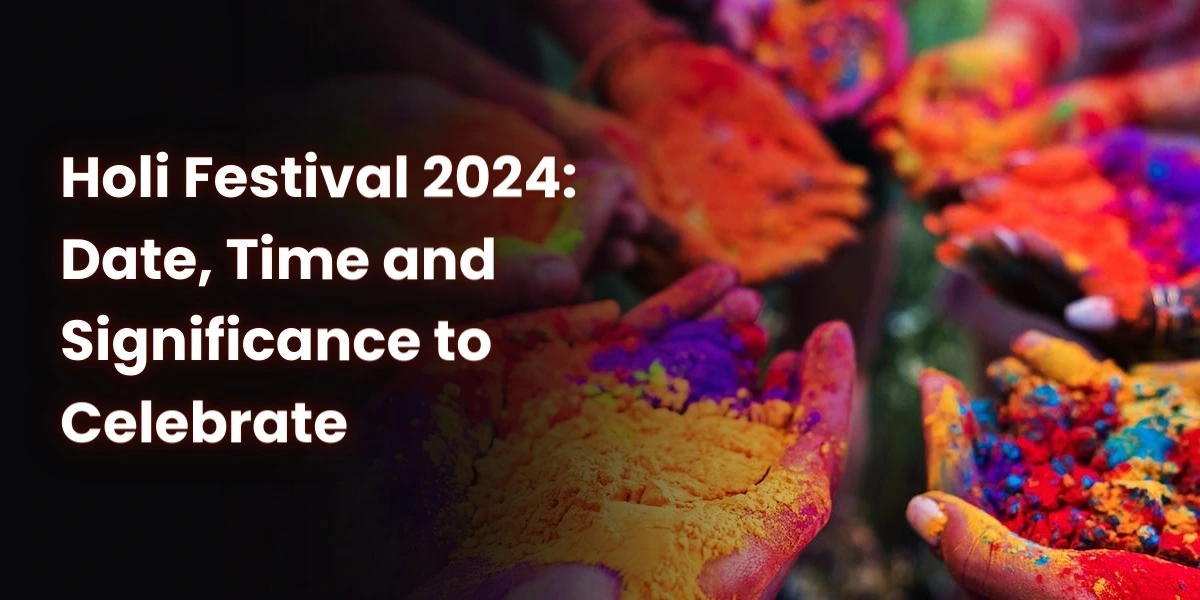Holi Festival 2024: Date, Time and Significance to Celebrate
Holi Festival 2024: Hindu tradition attaches tremendous significance to the two-day Holi celebration, which is a riot of color. It heralds the arrival of spring and the passing of winter by celebrating the triumph of good over evil. The festival also heralds the beginning of an abundant spring crop season.
On the evening of Purnima, a full moon day that occurs in the Hindu calendar month of Phalguna, the Holi celebrations begin. People participate in thrilling events like dancing, singing, tossing water and colorful powder at one another, and indulging in mouthwatering traditional foods throughout the celebration.
Holi Festival 2024 Date and Time
Holi Dahan: 24 March, Sunday (7:19 PM to 09:38 PM)
Holi Dhulendi: 25 March, Monday
Purnima Tithi Muhurat starts at 9:55 AM on 24th March
Purnima Tithi Muhurat ends at 12:30 PM on 25th March
Why do we celebrate Holi?
There are several reasons to celebrate Holi. First of all, it signifies the end of winter and the start of spring. It’s a time when people leave their houses to take advantage of the lovely weather and socialize with loved ones. Second, Holi is observed as a celebration of good triumphing over evil. People put aside their differences during this time to celebrate love and harmony. Thirdly, in some regions of India, Holi is observed as a harvest celebration. During this time, people offer prayers for a bountiful crop in the upcoming year and praise the gods for a healthy harvest.
Also Read: https://ptrahulshastri.com/luckiest-date-in-2024-according-to-zodiac-sign/
Holi Festival 2024 History and Significance
The Puranas claim that the history of Holi predates both the Ramayana and the Mahabharata. One of the four eras in Hindu mythology, Satyuga, was home to the powerful demon Hiranyakashipu. The fact that his son, Prahlad, was a devoted follower of Lord Vishnu deeply infuriated the demon king. He attempted to kill his son in multiple ways, but none of them worked. One method involved having Holika, his sister, sit next to Prahlad in a fire since she had a magical cloak that kept her safe from the flames.
But Lord Vishnu intervened as they were sitting in the fire, causing Holika to burn, and saving Prahlad. The villagers celebrated their victory over the demoness the following morning. Holi festival 2024 is celebrated to commemorate the triumph of good over evil for this reason.
According to another version, Lord Krishna had feelings for Radha but was afraid she wouldn’t accept him because he was dark and she was fair. He speared Radha’s face with colored powder, following his mother Yashoda’s advice, and that was how their romance started.
Holi Festival 2024 Mantra
1. अहकूटा भयत्रस्तै:कृता त्वं होलि बालिशैः अतस्वां पूजयिष्यामि भूति-भूति प्रदायिनीमः
2. गुरु गृह पढ़न गए रघुराई अल्पकाल विद्या सब पाई
3. ऊं नमों नग्न चीटी महावीर हूं पूरों तोरी आशा तूं पूरो मोरी आशा
4. ॐ नमो भगवते रुद्राय मृतार्क मध्ये संस्थिताय मम शरीरं अमृतं कुरु कुरु स्वाहा
Significance of Colours in Holi Festival 2024
At the Holi festival 2024, colors are important, and each color has a special meaning. The following are a few of the colors’ symbolic connotations during Holi:
1. Red: Red is a color associated with fertility and love. It represents Radha and Krishna’s unending love, and the color is frequently connected to life’s ardor and vitality.
2. Yellow: Turmeric, which has therapeutic qualities and is utilized in many Indian recipes, is yellow. It is also connected to the sun, a symbol of vitality and life.
3. Blue: Lord Krishna is frequently portrayed as having blue skin, and blue is his color. The infinite and the divine are symbolized by the color.
4. Green: The color green symbolizes growth and fresh starts. It represents the arrival of spring and the rebirth of the natural world.
5. Pink: The color pink is associated with joy, happiness, and friendliness. It’s frequently used to show affection and love.
There is also a societal meaning to the colors of the Holi Festival 2024. The event provides an occasion to celebrate diversity and unity while dismantling social boundaries. People from different castes and origins gather together to celebrate Holi and play with colors. The colors stand for both the vitality of life and the diversity of humanity. Holi’s colors have social as well as spiritual meanings. They stand for the variety of individuals and the different facets of life.

